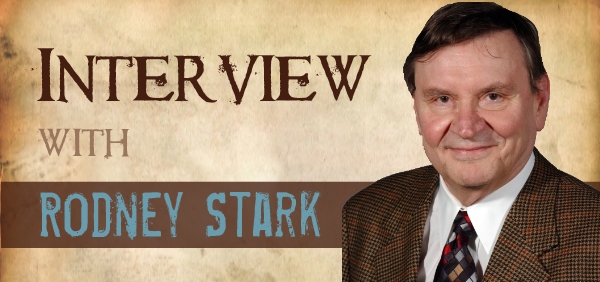Rodney William Stark (born July 8, 1934) is an American sociologist, self-declared agnostic (“personally incapable of religious faith”), but strongly committed to the Christian culture. He taught sociology and comparative religion at the University of Washington for many decades. He is Distinguished Professor of Social Sciences at Baylor University, co-director of the university’s Institute for Studies of Religion, and founding editor of the Interdisciplinary Journal of Research on Religion. Stark has written over 30 books, including The Rise of Christianity (1996), and more than 140 scholarly articles on subjects as diverse as prejudice, crime, suicide, and city life in ancient Rome. He has twice won the Distinguished Book Award from the Society for the Scientific Study of Religion: For The Future of Religion: Secularization, Revival, and Cult Formation (1985, with William Sims Bainbridge), and for The Churching of America 1776–1990 (1992, with Roger Finke). While not a believer himself, Stark strongly criticizes mythical anti-Catholicism, which dominates the American media and the academia. Particularly in his book Bearing False Witness (2016), he has argued that an anti-Catholic prejudice has poisoned the historical debate on the Crusades, the Inquisition and the relations of Pope Pius XII with Nazism, creating an “anti-Catholic history” that is at odds with contemporary academic research, yet is still taught in schools and promoted by mainline media.
In his excellent 1996 book ‘The Rise of Christianity’, Rodney Stark challenged a then majority consensus among historians, according to which the rise of early Christianity could not be explained without frequent mass conversions, and without a strong appeal of the Christian message to slaves and independent laborers. Stark’s challenge was well-prepared. In the early 1960s, he was the first social scientist to actually go out and watch people covert to a new religious movement. Together with John Lofland, he published this experience in the American Sociological Review (1965) 30: 862-875, under the title Becoming a World-Saver: a Theory of Conversion to a Deviant Perspective. Of course, in this title the adjective ‘deviant’ has the neutral, non-judgmental meaning of ‘opposed to main-stream’. His research concerned the ‘Moonies’, a dozen of young adults who had just moved to San Francisco from Eugene, Oregon, and led by Young Oon Kim, a Korean woman who had once been a professor of religion in Seoul. Lofland and Stark soon realized that most converts arose from Moonies’ friends, whose interpersonal attachments to members overbalanced their attachments to [critical] nonmembers. In effect, conversion is not about seeking or embracing an ideology; it is about bringing one’s religious behavior into alignment with that of one’s friends and family members (page 16 of ‘The Rise of Christianity’). From this field research, and many more studies, Stark later formulated the general rule that New religious movements mainly draw their converts from the ranks of the religiously inactive and discontented, and those affiliated with the most accommodated (worldly) religious movements.
Stark’s next step concerns the objective distinction between two kinds of religious movements: sects and cults. Sects occur by schism within conventional religious body when persons desiring a more otherworldly version of the faith break away to ‘restore’ the religion to a higher level of tension with its environment. (…) Cult movements (…) are new faiths (…) in the society being examined. They always start small (…). As new faiths, cult movements violate prevailing religious norms and are often target of considerable hostility (page 33). With these clear definitions at hand, Stark started counting. He found that among those who are attracted to cults (transcendental meditation, yoga, zen, mysticism) approximately 1:4 did not attend college. For people attracted to sects (faith healing, born again), this ratio was approximately 2:3. Even worse, all those attracted by cults had a high school education, while nearly two thirds of sectarians did not exceed the grade school level (tables 2.1 and 2.2 on page 41). Finally, table 2.3 on page 42 produces the member fractions who attended college. Lutherans, Methodists, and Catholics score just below 50%. Presbyterian score 61%, Congregational 63%, Episcopal 70%, and Jewish 76%. Cults (New Age, Scientology, Wiccan, Eckankar, Deity) score an unweighted average of 81%. Sects (Assemblies of God, Nazarene, Jehova’s Witnesses, Worldwide Church of God) score an unweighted average of 23%. Baptists were omitted for being too inhomogeneous. Agnostics score 72%, and unbelievers 53%. In chapter 3, Stark explains that Christianity started growing as any other known successful cult movement; that the majority of the Jewish population (living in the so-called Diaspora) converted to it during the first five centuries; that it was an urban movement; and that, at least in Rome, it was overrepresented in the households of high state dignitaries (including of the emperor himself) and among women.
How could we apply all this sociological wisdom to the Climate Church?
First of all, the teaching is radically new, as it flies in the face of all hitherto established scientific knowledge. By definition, the Climate Church therefore qualifies as a cult rather than as a sect. Moreover, the creed of the Climate Church mostly appeals to the better educated, economically well-to-do. This confirms the Church’s characterization as a cult movement. There are notable exceptions to Stark’s general rules, though:
- it did not start small;
- it did not violate prevailing religious norms;
- it never was target of hostility from society;
- it was always particularly hostile towards those who left the ranks.
The latter expression of intolerance towards non-believers is characteristic of sects though, not of cults. The other three exceptions make one think about possible causes…

